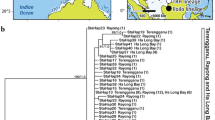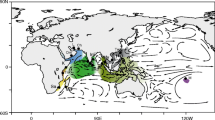Abstract
Phylogenetic, phylogeographic, population genetic and coalescence analyses were combined to examine the recent evolutionary history of the widespread Indo-Pacific parrotfish, Scarus psittacus, over a geographic range spanning three marine biogeographic realms. We sequenced 164 individuals from 12 locations spanning 17,000 km, from 55ºE to 143ºW, using 322 base pairs of mitochondrial control region (D-loop). S. psittacus displayed high haplotype (h = 0.83–0.98), but low nucleotide (<1%) diversity. Most (>83%) genetic variation was within populations. AMOVA revealed significant partitioning and identified five geographic groups. These included one central population and four populations peripheral to the centre. The central population occupied reefs from Western Australia to Tahiti and represented the central Indo-Pacific biogeographic realm. Cocos Keeling was distinct from central and western Indo-Pacific biogeographic realms occupying a position intermediate to these. Peripheral populations (Hawaii, Marquesas) represented the eastern Indo-Pacific biogeographic realm, while Seychelles represented the western Indo-Pacific biogeographic realm. All but the central population expanded (<163 kya). Whilst all populations experienced major sea level and SST changes associated with Pleistocene glaciation cycles, the genetic structure of the central population was relatively homogenous unlike the remaining genetically distinctive populations.




Similar content being viewed by others
References
Alfaro ME, Brock CD, Banbury BL, Wainwright PC (2009) Does evolutionary innovation in pharyngeal jaws lead to rapid lineage diversification in labrid fishes? BMC Evol Biol 9:255
Allen GR (2008) Conservation hotspots of biodiversity and endemism for Indo-Pacific coral reef fishes. Aquat. Conserv. Mar. Freshw. Ecosyst. 18:541–556
Alvarado Bremer JR, Baker AJ, Mejuto J (1995) Mitochondrial DNA control region sequences indicate extensive mixing of swordfish (Xiphias gladius) populations in the Atlantic Ocean. Can J Fish Aquat Sci 52:1720–1732
Anon (2000) SEQUENCHER Version 4. 1. 2. Gene Code Corporation, Ann Arbor, MI
Bay LK, Choat JH, van Herwerden L, Robertson DR (2004) High genetic diversities and complex genetic structure in an Indo-Pacific tropical reef fish (Chlorurus sordidus): evidence of an unstable evolutionary past? Mar Biol 144:757–767
Beerli P, Felsenstein J (2001) Maximum likelihood estimation of a migration matrix and effective population sizes in n subpopulations by using a coalescent approach. Proc Natl Acad Sci USA 98:4563–4568
Bellwood DR, Hughes TP (2001) Regional-scale assembly rules and biodiversity of coral reefs. Science 292:1532–1535
Bohonak AJ (2002) IBD (isolation by distance): a program for analyses of isolation by distance. J Hered 93:153–154
Bowen BW, Bass AL, Rocha LA, Grant WS, Robertson DR (2001) Phylogeography of the trumpet fishes (Aulostomus): ring species complex on a global scale. Evolution 55:1029–1039
Cabioch G, Montaggioni L, Frank N, Seard C, Sallé E, Payri C, Pelletier B, Paterne M (2008) Successive reef depositional events along the Marquesas foreslopes (French Polynesia) since 26 ka. Mar Geol 254:18–34
Chen L (2002) Post-settlement diet shift of Chlororus sordidus and Scarus schlegeli (Pisces: Scaridae). Zool. Stud. 41:47–58
Choat JH, Robertson DR (2002) Age-based studies on coral reef fishes. In: Sale PF (ed) Coral reef fishes. Dynamics and diversity in a complex ecosystem. Academic Press, New York
Choat JH, Axe LM, Lou DC (1996) Growth and longevity in fishes of the family Scaridae. Mar Ecol Prog Ser 145:33–41
Craig MT, Eble JA, Bowen BW, Robertson DR (2007) High genetic connectivity across the Indian and Pacific Oceans in the reef fish Myripristis berndti (Holocentridae). Mar Ecol Prog Ser 334:245–254
Dickenson WR (2000) Geomorphology and geodynamics of the Cook-Austral Island-Seamount Chain in the South Pacific Ocean: implications for hotspots and plumes. tectonic Studies of Asia and the Pacific Rim: a tribute to Benjamin M. Page (1911–1997). Geol. Soc Am 3:17–32 International Book Series
Drew J, Allen G, Kaufman L, Barber PH (2008) Endemism and regional colour and genetic differences in five putatively cosmopolitan reef fishes. Conserv Biol 22:965–975
Excoffier L, Laval G, Schneider S (2005) Arlequin ver. 3.1: an integrated software package for population genetics data analysis. Evol Bioinforma Online 1:47–50
Gaither MR, Toonen RJ, Robertson DR, Planes S, Bowen BW (2010) Genetic evaluation of marine biogeographical barriers: perspectives from two widespread Indo-Pacific snappers (Lutjanus kasmira and Lutjanus fulvus). J Biogeogr 37:133–147
Hall TA (1999) BioEdit: a user-friendly biological sequence alignment editor and analysis program for Windows 95/98/NT. Nucleic Acids Symp Ser 41:95–98
Harpending HC (1994) Signature of ancient population growth in a low-resolution mitochondrial DNA mismatch distribution. Hum Biol 66:591–600
Hobbs JP, Frisch AJ, Allen GR, van Herwerden L (2009) Marine hybrid hotspot at Indo-Pacific biogeographic border. Biol. Lett. 23:258–261
Horne JB, van Herwerden L, Choat JH, Robertson DR (2008) High population connectivity across the Indo-Pacific: congruent lack of phylogeographic structure in three reef fish congeners. Mol Phylogenet Evol 49:629–638
Huelsenbeck JP, Ronquist F (2001) MRBAYES: Bayesian inference of phylogenetic trees. Bioinformatics 17:754–755
Kazancioglu E, Near TJ, Hanel R, Wainwright PC (2009) Influence of sexual selection and feeding functional morphology on diversification rate of parrotfishes (Scaridae). Proc. R Soc. B 276:3439–3446
Klanten OS, Choat JH, van Herwerden L (2007) Extreme genetic diversity and temporal rather than spatial partitioning in a widely distributed coral reef fish. Mar Biol 150:659–670
Lacson JM, Clark S (1995) Genetic divergence of Maldivian and Micronesian demes of the damselfishes Stegastes nigricans, Chrysiptera biocellata, C. glauca and C. leucopoma (Pomacentridae). Mar Biol 121:585–590
Le Ray M, Beldade R, Holbrook SJ, Schmitt RJ, Planes S (2010) Allopatric divergence and speciation in coral reef fish: the three spot damselfish Dascyllus, Dascyllus trimaculatus, species complex. Evolution. doi:10.1111/j.1558-5646.2009.00917.x
Leis JM, Carson-Ewart BM (2000) The larvae of Indo-Pacific coastal fishes: an identification guide to marine fish larvae. Brill, Leiden
Malay MCD, Pauly G (2010) Peripatric speciation drives diversification and distributional pattern of reef hermit crabs (Decapoda:Diogenidae:Calcinus). Evolution. doi:10.1111/j.1558-5646.2009.00848.x
Mantel N (1967) The detection of disease clustering and generalized regression approach. Cancer Res 27:209–220
Martinez E, Maamaatuaiahutapu K (2004) Island mass effect in the Marquesas Islands: time variation. Geophys Res Lett 31:1–4
McMillan WO, Palumbi SR (1997) Rapid rate of control-region evolution in Pacific Butterfly fishes (Chaetodontidae). J Mol Evol 45:473–484
Messmer V, van Herwerden L, Munday P, Jones GP (2005) Phylogeography of colour polymorphism in the coral reef fish Pseudochromis fuscus, from Papua New Guinea and the Great Barrier Reef. Coral Reefs 24:392–402
Miller TI, Cribb TH (2007) Phylogenetic relationships of some common Indo-Pacific snappers (Perciformes:Lutjanidae) based on mitochondrial DNA sequences, with comments on the taxonomic position of the Caesioninae. Mol Phylogenet Evol 44:450–460
Mooi RD, Gill AC (2001) Historical biogeography of fishes. In: Hart PJB, Reynolds JD (eds) Handbook of fish biology and fisheries. Blackwell Publishing, Oxford, pp 43–68
Nei M (1987) Molecular evolutionary genetics. Columbia University Press, New York
Nishiguchi MK, Doukakis P, Egan M, Kizirian D, Phillips A, Prendini L, Rosenbaum HC, Torres E, Wyner Y, DeSalle R, Giribet G (2002) Methods and tools in biosciences and medicine: techniques in molecular systematics and evolution DNA isolation procedures. Birkhauser, Basal
Parenti P, Randall JE (2001) An annotated checklist of the species of the labroid fish, families Labridae and Scaridae. Ichthyol. Bull. 68:1–97
Pianka ER (1978) Evolutionary ecology. Harper and Row, New York
Planes S, Fauvelot C (2002) Isolation by distance and vicariance drive genetic structure of a coral reef fish in the Pacific Ocean. Evolution 56:378–399
Posada D, Crandall KA (1998) MODELTEST: testing the model of DNA substitution. Bioinformatics 14:817–818
Randall JE (1998) Zoogeography of shore fishes of the Indo-Pacific region. Zool. Stud 31:227–268
Randall JE (2001) Four new cardinal fishes (Perciformes:Apogonidae) from the Marquesas Islands. Pac Sci. 55:47–64
Rocha LA, Bowen BW (2008) Speciation in reef fishes. J Fish Biol 72:1101–1121
Rocha LA, Robertson DR, Roman J, Bowen BW (2005) Ecological speciation in tropical reef fishes. Proc. R Soc. Lond B 272:573–579
Rogers AR, Harpending HC (1992) Population-growth makes waves in the distribution of pairwise genetic-differences. Mol Biol Evol 9:552–569
Rohlf FJ (1973) Algorithm 76. Hierarchical clustering using the minimum spanning tree. Comput. J. 16:93–95
Sambrook J, Fritch E, Maniatis T (1989) Molecular cloning, a laboratory manual. Cold Spring Harbour Laboratory Press, Cold Spring Harbour
Sathiamurthy E, Voris HK (2006) Maps of Holocene sea level transgression and submerged lakes on the Sunda Shelf. The Natural History Journal of Chulalongkorn University, Supplement 2, pp 1–44
Schneider S, Roessli D, Excoffier L (2000) Arlequin: a software for population genetics data analysis. Genetics and Biometry Laboratory, Department of Anthropology and Ecology, University of Geneva. 111 p. Available via http://anthro.unige.ch/software/arlequin/software/2.000/manual/Arlequin.pdf
Shimodaira H, Hasegawa M (2001) CONSEL: for assessing the confidence of phylogenetic tree selection. Bioinformatics 17:1246–1247
Slatkin M (1993) Isolation by distance in equilibrium and non-equilibrium populations. Evolution 471:264–279
Sosdian S, Rosenthal Y (2009) Deep-sea temperature and ice volume changes across the Pliocene–Pleistocene climate transitions. Science 325:306–310
Spalding MD, Fox HE, Allen GR, Davidson N, Ferdana ZA, Finlayson M, Halpern BS, Jorge MA, Lombana AL, Lourie SA, Martin KD, McManus E, Molnar J, Recchia CA, Robertson J (2007) Marine ecoregions of the world: a bioregionalization of coastal and shelf areas. Bioscience 57:573–583
Swofford DL (2003) PAUP*. Phylogenetic analysis using parsimony. Sinauer Associates, Sunderland, MA
Tamura K, Dudley J, Nei M, Kumar S (2007) MEGA4: molecular evolutionary genetics analysis (MEGA) software version 4.0. Mol. Biol. Evolution 24:1596–1599
Veron J (2000) Corals of the world. Australian Institute of Marine Science, Townsville, QLD
Voris HK (2000) Maps of Pleistocene sea levels in Southeast Asia: shorelines, river systems and time durations. J Biogeogr 27:1153–1167
Werner R (2008) New insights into the geodynamic history of northern Wharton Basin (South-East Indian Ocean) Eos Trans AGU, 89 (53) Fall Meet. Suppl, Abstract
Westneat MW, Alfaro ME (2005) Phylogenetic relationships and evolutionary history of the reef fish family Labridae Mol. Phylogenet. Evol. 36:370–390
Wolstenholme DR (1992) Animal mitochondrial DNA: structure and evolution. Int Rev Cytol 141:173–216
Woodroffe CD, Veeh HH, Falkland AC, McLean RF, Wallensky E (1991) Last interglacial reef and subsidence of the Cocos (Keeling) Islands, Indian Ocean. Mar Geol 96:137–143
Zwickl DJ (2006) GARLI. Program distributed by the author. Section of Integrative Biology, The University of Texas at Austin. Available at http://www.zo.utexas.edu/faculty/antisense/Garli.html
Acknowledgments
Funding and logistic support were provided by The National Geographic Society, (Cocos Keeling, Marquesas), The Queensland Government/Smithsonian Institution Collaborative Research Program on Reef Fishes, The Smithsonian Institution, The Seychelles Fishing Authority, Cocos Keeling and Christmas Island National Parks, Department of Environment and Heritage Australia, The Taiwan National Museum, The Australian Institute of Marine Science, The Lizard Island Research Station, the University of Guam Marine Laboratory; University of Hawaii Marine Laboratory and the James Cook University internal funding scheme. Tahiti specimens were collected by M. Meekan, W. Murray, R. Thorne, J. Robinson, J. Ackerman, W. Robbins, Li Shu Chen and L. Rocha. C. Birkeland provided logistic and field assistance, collection of specimens and access to Museum material. Collections on the GBR were carried out under GBRMPA Permit number G03/3871.1. S. Klanten, D. Blair and the JCU Molecular Ecology and Evolution Laboratory assisted with laboratory work and analysis. The work was carried out under James Cook University Ethics Approval No. A503.
Author information
Authors and Affiliations
Corresponding author
Additional information
Communicated by T. Reusch.
Rights and permissions
About this article
Cite this article
Winters, K.L., van Herwerden, L., Choat, J.H. et al. Phylogeography of the Indo-Pacific parrotfish Scarus psittacus: isolation generates distinctive peripheral populations in two oceans. Mar Biol 157, 1679–1691 (2010). https://doi.org/10.1007/s00227-010-1442-4
Received:
Accepted:
Published:
Issue Date:
DOI: https://doi.org/10.1007/s00227-010-1442-4




